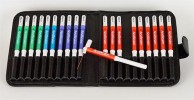Authors
S.Ng Wing Tin, D.Ciampi de Andrade, C.Goujon
Lab
Faculté de Médecine, Université Paris Est Créteil,Créteil, France
Journal
Clinical Neurophysiology
Abstract
ObjectiveTo characterize sensory threshold alterations in peripheral neuropathies and the relationship between these alterations and the presence of pain.
MethodsSeventy-four patients with length-dependent sensory axonal neuropathy were enrolled, including 38 patients with painful neuropathy (complaining of chronic, spontaneous neuropathic pain in the feet) and 36 patients with painless neuropathy. They were compared to 28 age-matched normal controls. A standardized quantitative sensory testing protocol was performed in all individuals to assess large and small fiber function at the foot. Large fibers were assessed by measuring mechanical (pressure and vibration) detection thresholds and small fibers by measuring pain and thermal detection thresholds.
ResultsBetween patients with neuropathy and controls, significant differences were found for mechanical and thermal detection thresholds but not for pain thresholds. Patients with painful neuropathy and those with painless neuropathy did not differ regarding mechanical or thermal thresholds, but only by a higher incidence of thermal or dynamic mechanical allodynia in case of painful neuropathy. Pain intensity correlated with the alteration of thermal detection and mechanical pain thresholds.
ConclusionsQuantitative sensory testing can support the diagnosis of sensory neuropathy when considering detection threshold measurement. Thermal threshold deterioration was not associated with the occurrence of pain but with its intensity.
SignificanceThere is a complex relationship between the loss or functional deficit of large and especially small sensory nerve fibers and the development of pain in peripheral neuropathy.
BIOSEB Instruments Used:
Von Frey Filaments (Bio-VF-M)

 Pain - Thermal Allodynia / Hyperalgesia
Pain - Thermal Allodynia / Hyperalgesia Pain - Spontaneous Pain - Postural Deficit
Pain - Spontaneous Pain - Postural Deficit Pain - Mechanical Allodynia / Hyperalgesia
Pain - Mechanical Allodynia / Hyperalgesia Learning/Memory - Attention - Addiction
Learning/Memory - Attention - Addiction Physiology & Respiratory Research
Physiology & Respiratory Research
 Pain
Pain Central Nervous System (CNS)
Central Nervous System (CNS) Neurodegeneration
Neurodegeneration Sensory system
Sensory system Motor control
Motor control Mood Disorders
Mood Disorders Other disorders
Other disorders Muscular system
Muscular system Joints
Joints Metabolism
Metabolism Cross-disciplinary subjects
Cross-disciplinary subjects Preclinical studies and opioids: role in crisis management in the United States
Preclinical studies and opioids: role in crisis management in the United States 